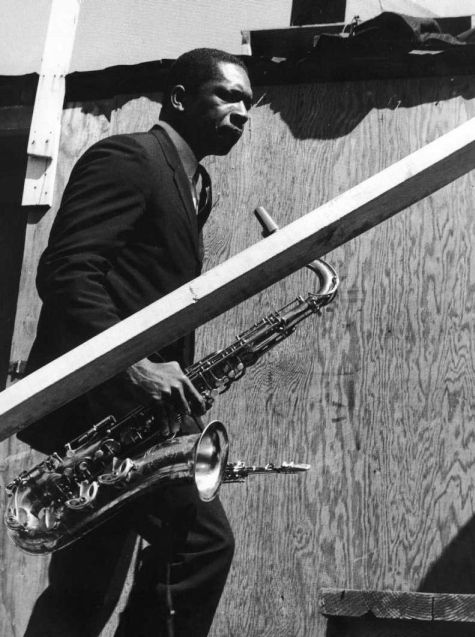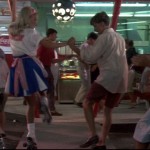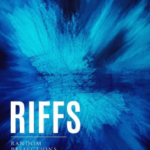
John Coltrane, saxophonist and visionary, set standards in nearly every facet of his short but ultimately fruitful life. While generally associated with Philadelphia, Coltrane is actually from Hamlet, North Carolina, and never tried to hide his Southern roots. In an interview by author Frank Kofsky — one of the few times his voice was recorded — the usually soft-spoken Coltrane gives casual yet measured responses to provocative questions in a thick Southern drawl. This casual treatment of the provocative was a reoccurring theme with Afro-American musicians sartorially inclined toward the Ivy League Look, especially those whose matriculation in post-Jim Crow America was almost never casual but always provocative.
In “Men of Color,” Lloyd Boston writes, “Avant-garde sax-man John Coltrane’s music may have been ‘giant steps’ ahead, but he favored an understated style of dress: single-breasted sack suits, buttondown oxford shirts, and plain ties.”
John Coltrane’s musical trajectory gave birth to what is now known as postmodern saxophone playing, while his sartorial sense facilitated the goals of a legend in the making with more to concern himself with than the roll of the buttondown collars he was often seen in, or whether the sleeve on his terrycloth-knit polo hit his bicep at just the right spot.
Trane, as he’s affectionately referred to, had style in spades because he never seemed to have time to look anything but correct and presentable. Yet in hindsight his photographs seem to have been styled by Frank Muytjens: natural-shouldered, three-button jacket paired with a buttondown-collar shirt (with or without tie), odd trousers and typically penny loafers. Add to that look an austere haircut, occasional neat mustache, and nothing less than the most fertile musical imagination in jazz and there you have John Coltrane, musician. — JASON MARSHALL
The following are some samples of Coltrane’s music. First, one of his best-known compositions:
Next, a visual primer on how jazz is made:
Finally, Coltrane’s take on a tune from Franz Lehar’s operetta “The Merry Widow”:











The 13th note is also a question of…style.
Great post. Thank u.
G.
It would seem impossible for an African American who is both sartorially inclined and socially conscious to separate completely the trad/prep/ivy-league aesthetic and the attitudes and behavior of its progenitors. Yours truly no exception.
Gorgeous post. As a jazz musician as well as “an African American who is both sartorially inclined and socially conscious”, I have found the entirety of your “Black History Month Series” to be not only esthetically inspiring, but also culturally. Thank you for your great work this month, as well as your dedication to providing diverse takes on “Ivy Style” throughout the year.
All of my best,
April Inez Kaplowitz
I must have missed this the first time around. That take on “The Merry Widow” is worth the post alone, though I might have said Trane was outfitted by someone other than Muytjens.
I think my favorite of his is My Favorite Things. Genius
An inspiring post. I now look forward to weekend of listening to Trane while reading WFB and DPM essays.
As he ascends those stairs you can just see the soprano saxophone Coltrane is holding in his left hand. I think it’s worth mentioning that he single-handedly reintroduced that wonderful instrument to jazz…at the same time totally reinventing saxophone playing.
There was no one like him. Giant Steps. Giant Player.
I think a good part of the impact of Coltrane’s “My Favorite Things” — the pace, the complexity, and, yes, the key it’s played in — has to do with its contrast to the charming, but a-little-too-sentimental version in the musical and the film.
A lot of the standards, many originally from musicals, were given a critical, even ironic, treatment by jazz musicians. Coltrane’s version manages to be both critical (i.e., distanced from the original) and exuberant at the same time.
For a flattening out, and an updating of Coltrane’s version, listen to Andre 3000’s take on it from The Love Below (part of the double album Speakerboxxx/The Love Below by OutKast released in 2003).
As for favorites when Coltrane in mentioned, the first thing that comes to mind is “Teo” with Miles Davis, but there are so many others. One of the truly greats.
Color doesn’t matter. I love Coltrane as much as Mulligan, Giuffre, Moody, Getz, Yardbird, Rollins…too many to mention. On the other hand, Dexter Gordon always seemed a bit jive to me and I believe he was black.
Incidentally, have you guys ever listened to Cannonball Adderly with Nancy Wilson on vinyl. Great stuff.
Will
The tune from The Merry Widow is “Vilia”:
http://youtu.be/DTmZSD2E1Jo
There’s no way I could leave the last comment of a Coltrane thread with a Yamaha version of anything, let alone something from what, the Merry Widow???
So, all you cool cats, hanging loose in your soft shoulder ties/oxford threads/penny BDs/knitted loafers, get a load of this:
https://www.youtube.com/watch?v=03juO5oS2gg
Love Supreme. Masterful. Thank you Mr Coltrane for your genius. Awesome post.
Being a Latin (American) music fanatic one of my favourite things is the New Swing Sextet version of My Favourite Things: https://www.youtube.com/watch?v=5GVK0rYLh4I.
Ideal for listening and/or dancing a mambo.